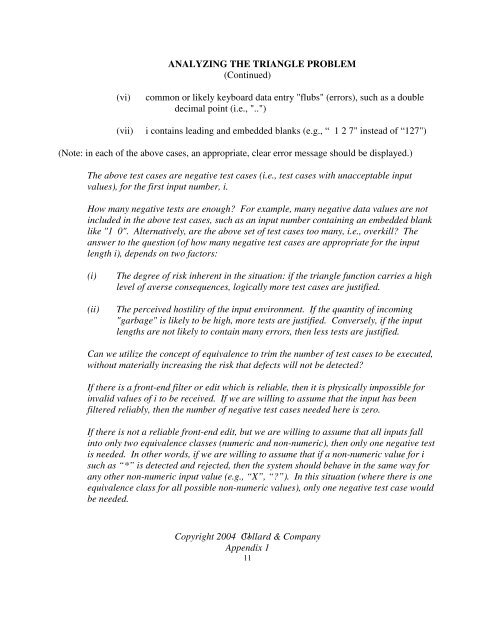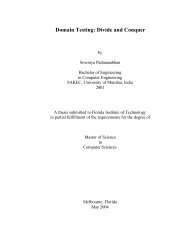appendix 1. analyzing the triangle problem - Testing Education
appendix 1. analyzing the triangle problem - Testing Education
appendix 1. analyzing the triangle problem - Testing Education
Create successful ePaper yourself
Turn your PDF publications into a flip-book with our unique Google optimized e-Paper software.
ANALYZING THE TRIANGLE PROBLEM<br />
(Continued)<br />
(vi) common or likely keyboard data entry "flubs" (errors), such as a double<br />
decimal point (i.e., "..")<br />
(vii) i contains leading and embedded blanks (e.g., “ 1 2 7" instead of “127")<br />
(Note: in each of <strong>the</strong> above cases, an appropriate, clear error message should be displayed.)<br />
The above test cases are negative test cases (i.e., test cases with unacceptable input<br />
values), for <strong>the</strong> first input number, i.<br />
How many negative tests are enough? For example, many negative data values are not<br />
included in <strong>the</strong> above test cases, such as an input number containing an embedded blank<br />
like "1 0". Alternatively, are <strong>the</strong> above set of test cases too many, i.e., overkill? The<br />
answer to <strong>the</strong> question (of how many negative test cases are appropriate for <strong>the</strong> input<br />
length i), depends on two factors:<br />
(i) The degree of risk inherent in <strong>the</strong> situation: if <strong>the</strong> <strong>triangle</strong> function carries a high<br />
level of averse consequences, logically more test cases are justified.<br />
(ii) The perceived hostility of <strong>the</strong> input environment. If <strong>the</strong> quantity of incoming<br />
"garbage" is likely to be high, more tests are justified. Conversely, if <strong>the</strong> input<br />
lengths are not likely to contain many errors, <strong>the</strong>n less tests are justified.<br />
Can we utilize <strong>the</strong> concept of equivalence to trim <strong>the</strong> number of test cases to be executed,<br />
without materially increasing <strong>the</strong> risk that defects will not be detected?<br />
If <strong>the</strong>re is a front-end filter or edit which is reliable, <strong>the</strong>n it is physically impossible for<br />
invalid values of i to be received. If we are willing to assume that <strong>the</strong> input has been<br />
filtered reliably, <strong>the</strong>n <strong>the</strong> number of negative test cases needed here is zero.<br />
If <strong>the</strong>re is not a reliable front-end edit, but we are willing to assume that all inputs fall<br />
into only two equivalence classes (numeric and non-numeric), <strong>the</strong>n only one negative test<br />
is needed. In o<strong>the</strong>r words, if we are willing to assume that if a non-numeric value for i<br />
such as “*” is detected and rejected, <strong>the</strong>n <strong>the</strong> system should behave in <strong>the</strong> same way for<br />
any o<strong>the</strong>r non-numeric input value (e.g., “X”, “?”). In this situation (where <strong>the</strong>re is one<br />
equivalence class for all possible non-numeric values), only one negative test case would<br />
be needed.<br />
Copyright 2004 Collard 11 & Company<br />
Appendix 1<br />
11








